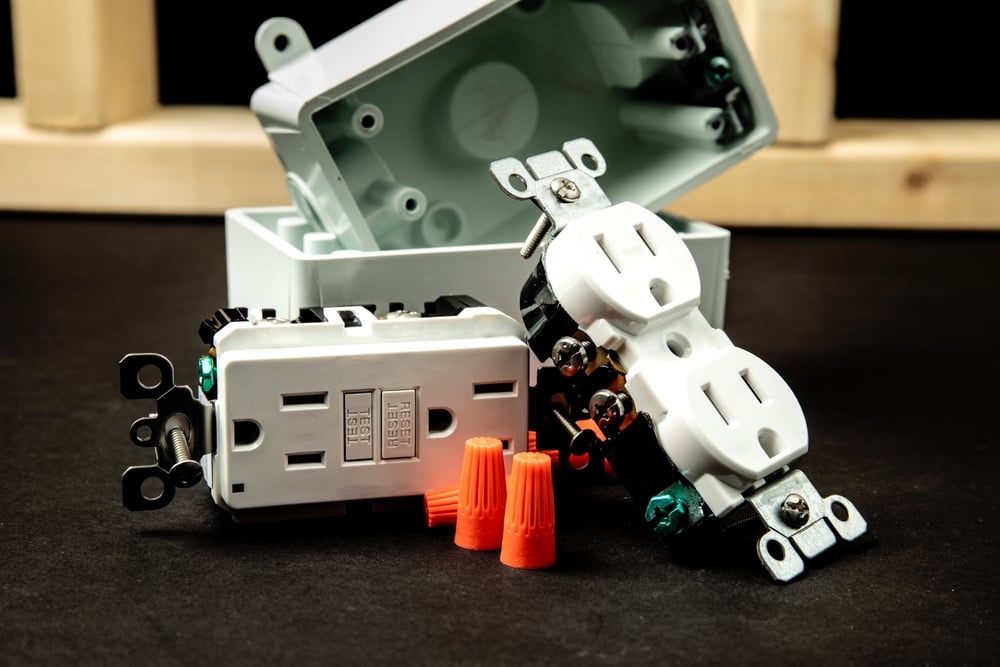GFCI Outlets Are Cheap Insurance Against Deadly Shocks.
It’s called a ground fault circuit interrupter, or GFCI for short. This electric outlet protects your family from deadly shocks from faulty plug-in cords and devices.
Before We Start, Some GFCI Basics
- This special type of outlet detects ground faults and immediately shuts off the power. You can replace just about any electrical outlet with a GFCI outlet, and even protect other outlets on the same circuit.
- You’ll usually find GFCI outlets in bathrooms and kitchens. They should be installed in any other areas that can get wet or damp, such as the laundry room, basement, garage, workshop, and on porches, decks and patios.
- An entire circuit can be protected by one ground fault circuit interrupter if it’s the first outlet on that circuit, and a GFCI breaker installed in the breaker box can protect an entire circuit.
- In a house with two bathrooms, the GFCI receptacle could be in one while the circuit continues to the other. If the GFCI in the second bathroom is activated, you need to reset the outlet in the first bathroom.
- A GFCI receptacle has connectors marked “line” and “load.” The line connectors are for the power coming into the outlet. The load connections are for power going out to any downstream outlets on the circuit.
- GFCI receptacles need to be easily accessible, not hidden behind heavy appliances like your refrigerator or dishwasher. While GFCIs are installed in newer homes, they can stop working, so you need to know how to replace them.
How to Replace an Existing GFCI Receptacle.
Chris Lozano is a licensed master electrician who has 10 years of experience. As one of our trusted Frontdoor Experts, Chris contributed his insights to help guide you through replacing an existing GFCI receptacle.
Follow these steps below to replace an existing GFCI receptacle. If at any point during this process you feel uncomfortable or have questions, download the Frontdoor app and video chat with an Expert who will walk you through it!
Step 1: Gather your GFCI wiring supplies:
- Wire strippers
- Philips screwdriver and a small to medium flathead
- Electrical tape
- GFCI receptacle
- Decorative cover plate
- Wire nuts
- Non-contact voltage tester
Make sure you wear gloves to prevent cuts and scrapes from the sharp metal on the box and GFCI.
Step 2: Shut down the power by turning the breaker or fuse that controls the outlet you’re replacing. Test the wire with a non-contact voltage tester. Plug a lamp, radio or the GFCI tester into the outlet to make sure it’s off.
Step 3: Remove the old outlet. Disconnect the wires by loosening the terminal screws on each side of the outlet and taking the wires off the terminals.
Note: Make sure you know the difference between line vs. load GFCI. As noted above, line connectors are for the power coming into the outlet while load connections are for power going out to downstream outlets.
Step 4: Strip the insulation from the wires to expose the amount of wire you’ll see on the stripping gauge on the back of the GFCI plug receptacle. Connect the hot and neutral wires providing power to the line terminals of the GFCI plug. The terminal for the neutral wire is marked “white” or “neutral.”
Step 5: Connect the other outlets. Remove the tape covering the load terminals and connect the wires leading to another outlet or outlets to these terminals (the white neutral terminal is marked). Fold the wires back into the box and attach the GFCI receptacle and cover plate.
Step 6: Label the outlets. Attach the “GFCI-protected outlet” label to the downstream outlets.
Test the downstream outlet by plugging in the GFCI tester and pressing the “test” button—if it’s working correctly, the lights on the tester should go out. Then press the reset button on the GFCI.
Make Sure to Test Regularly.
After installing a GFCI outlet, it should be tested monthly to ensure it’s providing protection. Press the test button, then the reset button. If the indicator light does not go out and come back on, or if the GFCI cannot be reset, it must be replaced.
Understanding GFCI wiring will allow you to replace faulty GFCIs and keep your home safe and up to code.
If at any point as you’re installing a GFCI outlet you run into problems or have a question, don’t hesitate to download the Frontdoor® app and let one of our Experts walk you through the process. With unlimited video chats, there’s no reason to put off getting help with any household project, big or small.
Was this article helpful?



